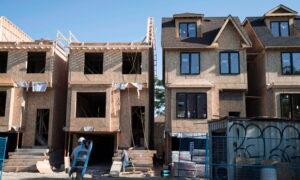The Canadian Real Estate Association says it is scaling back its housing market forecast for the remainder of the year amid increased levels of supply and a quiet spring spurred by fewer interest rate cuts expected in 2024.
The association said on July 12 it anticipates a gradual rebound in the national housing market, with 472,395 properties forecast to trade hands this year to mark a 6.1 percent increase from 2023—down from its forecast in April of a 10.5 percent gain.
The revised forecast came as CREA reported the latest national home sales and pricing data for June.
On a year-over-year basis, the number of homes that changed hands in the month fell 9.4 percent, reflecting stronger activity in spring 2023. But CREA said sales ticked up 3.7 percent on a month-over-month basis.
“It wasn’t a ‘blow the doors off’ month by any means, but Canada’s housing numbers did perk up a bit on a month-over-month basis in June following the first Bank of Canada rate cut,” said CREA senior economist Shaun Cathcart in a press release.
It said the average price of a home sold last month amounted to $696,179, down 1.6 percent from June 2023. Nationally, prices ticked up 0.1 percent compared with May, the first month-over-month gain in 11 months.
“This could be a harbinger of improved activity ahead,” said TD economist Rishi Sondhi in a note.
“Indeed, we think that markets will be stronger in the back half of the year, as the economy holds up and more meaningful interest rate relief is delivered. However, stretched affordability conditions will likely limit the degree of improvement.”
CREA said it is now forecasting just a 2.5 percent annual increase in the average price of a home for 2024 to to $694,393. That’s down from its previous forecast of a 4.9 percent increase.
The Bank of Canada began its rate-lowering process with a June 5 cut that brought its key interest rate down to 4.75 percent from five percent.
There were about 180,000 properties listed for sale across Canada at the end of June, up 26 percent from a year earlier but still below historical averages of around 200,000 for this time of the year.
New listings grew a 1.5 percent month-over-month increase in June, led by the Greater Toronto Area and B.C. Lower Mainland.







